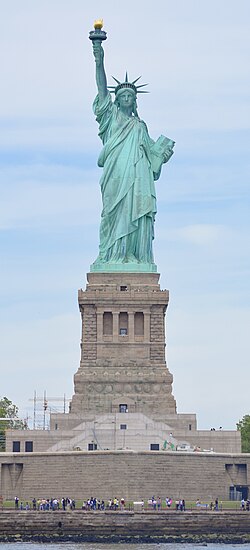
Back Vryheidstandbeeld Afrikaans Freiheitsstatue ALS የአርነት ሐውልት Amharic Estatua d'a Libertat AN تمثال الحرية Arabic تمثال الحريه (نيويورك) ARZ Estatua de la Llibertá AST Nuyuca koafisa va tamava AVK Azadlıq heykəli Azerbaijani آزادلیق موجسمهسی AZB
| |
|---|---|
 | |
| Location | Liberty Island New York City |
| Coordinates | 40°41′21″N 74°2′40″W / 40.68917°N 74.04444°W |
| Height |
|
| Dedicated | October 28, 1886 |
| Restored | 1938, 1984–1986, 2011–2012 |
| Sculptor | Frédéric Auguste Bartholdi |
| Visitors | 3.2 million (in 2009)[1] |
| Governing body | National Park Service |
| Website | nps |
| Type | Cultural |
| Criteria | i, vi |
| Designated | 1984 (8th session) |
| Reference no. | 307 |
| Region | Europe and North America |
| Designated | October 15, 1924 |
| Designated by | President Calvin Coolidge[2] |
| Official name | The Statue of Liberty Enlightening the World[3][4] |
| Designated | September 14, 2017 |
| Reference no. | 100000829 |
| Official name | Statue of Liberty National Monument, Ellis Island and Liberty Island |
| Designated | May 27, 1971 |
| Reference no. | 1535[5] |
| Designated | June 23, 1980[6] |
| Reference no. | 06101.003324 |
| Type | Individual |
| Designated | September 14, 1976[7] |
| Reference no. | 0931 |
The Statue of Liberty (Liberty Enlightening the World; French: La Liberté éclairant le monde) is a colossal neoclassical sculpture on Liberty Island in New York Harbor, within New York City. The copper-clad statue, a gift to the United States from the people of France, was designed by French sculptor Frédéric Auguste Bartholdi and its metal framework was built by Gustave Eiffel. The statue was dedicated on October 28, 1886.
The statue is a figure of a classically draped woman,[8] likely inspired by the Roman goddess of liberty Libertas.[9] In a contrapposto pose,[8][10] she holds a torch above her head with her right hand, and in her left hand carries a tabula ansata inscribed JULY IV MDCCLXXVI (July 4, 1776, in Roman numerals), the date of the U.S. Declaration of Independence. With her left foot she steps on a broken chain and shackle,[8] commemorating the national abolition of slavery following the American Civil War.[11][12][13] After its dedication the statue became an icon of freedom and of the United States, being subsequently seen as a symbol of welcome to immigrants arriving by sea.
The idea for the statue was conceived in 1865, when the French historian and abolitionist Édouard de Laboulaye proposed a monument to commemorate the upcoming centennial of U.S. independence (1876), the perseverance of American democracy and the liberation of the nation's slaves.[14] The Franco-Prussian War delayed progress until 1875, when Laboulaye proposed that the people of France finance the statue and the United States provide the site and build the pedestal. Bartholdi completed the head and the torch-bearing arm before the statue was fully designed, and these pieces were exhibited for publicity at international expositions.
The torch-bearing arm was displayed at the Centennial Exposition in Philadelphia in 1876, and in Madison Square Park in Manhattan from 1876 to 1882. Fundraising proved difficult, especially for the Americans, and by 1885 work on the pedestal was threatened by lack of funds. Publisher Joseph Pulitzer, of the New York World, started a drive for donations to finish the project and attracted more than 120,000 contributors, most of whom gave less than a dollar (equivalent to $34 in 2023). The statue was built in France, shipped overseas in crates, and assembled on the completed pedestal on what was then called Bedloe's Island. The statue's completion was marked by New York's first ticker-tape parade and a dedication ceremony presided over by President Grover Cleveland.
The statue was administered by the United States Lighthouse Board until 1901 and then by the Department of War; since 1933, it has been maintained by the National Park Service as part of the Statue of Liberty National Monument, and is a major tourist attraction. Limited numbers of visitors can access the rim of the pedestal and the interior of the statue's crown from within; public access to the torch has been barred since 1916.
- ^ Cite error: The named reference
Schneidermanwas invoked but never defined (see the help page). - ^ Cite error: The named reference
monumentswas invoked but never defined (see the help page). - ^ "Liberty Enlightening the World". Washington, D.C.: National Park Service. Archived from the original on January 1, 2020. Retrieved February 12, 2020.
- ^ Weekly List of Actions Taken on Properties: 9/08/2017 through 9/14/2017, National Park Service, September 14, 2017, archived from the original on December 29, 2018, retrieved July 13, 2019.
- ^ "New Jersey and National Registers of Historic Places – Hudson County". New Jersey Department of Environmental Protection – Historic Preservation Office. Archived from the original on October 9, 2014. Retrieved August 2, 2014.
- ^ "Cultural Resource Information System (CRIS)". New York State Office of Parks, Recreation and Historic Preservation. November 7, 2014. Retrieved July 20, 2023.
- ^ Cite error: The named reference
neighborwas invoked but never defined (see the help page). - ^ a b c Hayden & Despont 1986, p. 45.
- ^ Sutherland 2003, p. 19.
- ^ Khan 2010, p. 113.
- ^ Jacobs, Julia (May 15, 2019). "New Statue of Liberty Museum Illuminates a Forgotten History". The New York Times. Archived from the original on June 21, 2024. Retrieved July 22, 2024.
- ^ "Celebrate Lady Liberty". The Statue of Liberty—Ellis Island Foundation. October 25, 2021. Retrieved July 22, 2024.
- ^ "Abolition". Statue of Liberty National Monument. National Park Service. February 26, 2015. Archived from the original on November 8, 2019. Retrieved November 18, 2019.
- ^ "The French Connection". National Park Service. May 19, 2019. Retrieved June 10, 2023.